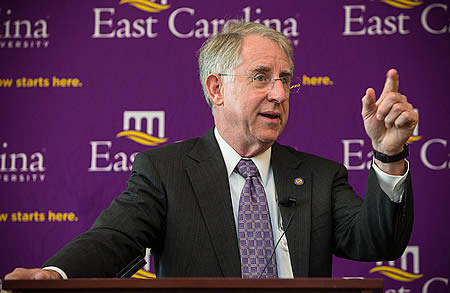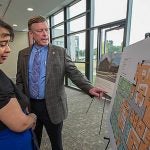Reaching Robeson
'The heart of who we want to be'
LUMBERTON, N.C. (Sept. 17, 2013) — Robeson County will soon be home to a facility that officials say will bring dental care to limited-income, underserved residents while providing educational opportunities to East Carolina University dental students.
That was the message Sept. 16 as Robeson leaders and the ECU School of Dental Medicine announced plans to build a “community service learning center” in Lumberton.

Dr. Greg Chadwick, dean of the ECU School of Dental Medicine, speaks at the Lumberton announcement. Photos by Cliff Hollis
ECU will build the facility next to the Robeson County Health Department on land donated by the county. Construction dates will be announced later.
Leaders in Robeson County and at East Carolina said the location in this statistically underserved border county illustrates the seriousness and reach of the university’s mission of service.
“We are very honored that East Carolina University decided to put the program here,” said Noah Woods, chairman of the Robeson County Board of Commissioners, at a public event announcing the location. “We are honored to have this fine institution with a record of service as our partner.”
Chancellor Steve Ballard told the group, “This (dental school outreach) is the heart of who we want to be, who we ought to be and who we are.”
At the center, fourth-year dental students and dental residents will hone their patient-care techniques and learn the ins-and-outs of operating a community practice under the watch of experienced faculty members. It is the seventh center ECU has announced since it began its new dental school in 2008.
Teaching dentists statewide
The $3 million, 7,700-square-foot center is one of up to 10 ECU plans to build across the state. The first two centers have opened in Ahoskie and Elizabeth City. Two more are under construction in Lillington in the central part of the state and Sylva in the mountains. Others are planned for the mountain town of Spruce Pine and in Davidson County in the Triad.
“We are excited about working with the county health department and the local dental community and look forward to providing quality dental care to people of Robeson County and the surrounding counties,” said Dr. Gregory Chadwick, dean of the School of Dental Medicine at ECU.
The center will have 16 dental chairs and will employ local staff members, including 1.5 full-time dental faculty positions, a business manager, five to six dental assistants, two to three dental hygienists and two general dentistry residents. Four to five students will be at the center for nine-week rotations.
Once open, the center will provide a variety of services, including general, preventive and emergency dental care and will include services such as crowns, root canals and bridges.
While services won’t be free, charges will be on a sliding scale. Officials have said fees typically will be about 70 percent of those at a private dental practice.
ECU approach distinct
William Smith, director of the Robeson County Health Department, said the center will help the 14,000 people in his county who don’t qualify for Medicaid or insurance under the Affordable Care Act. The department closed its dental center in July due to financial pressures after the state did not expand its Medicaid program.
“I think not only for Robeson County but the region as a whole the clinic is going to be vital for a segment of our population that heretofore has not accessed dental care,” Smith said.
The school admitted its first class in 2011, and all students are North Carolina residents. Goals of the school are to educate students from underrepresented groups and disadvantaged backgrounds and to improve access to dental care.
“The ECU approach – educating students and residents in our community service learning centers – could become a future model for dental education,” Chadwick said. “Community service learning centers are more than just dental clinics. They are an integral part of our dental school where our seniors will spend much of their fourth year.”
One of those ECU dental students who will train at the community service learning centers being built across the state is Lumberton native Kasey Oxendine.
The second-year student knows the need for dental care in Robeson County first-hand. She remembers as a child in Lumberton having a toothache and having to wait to see a dentist.
“Robeson County is one of the poorest and largest counties in the state. As a child, I experienced the lack of access to care when I had to wait an extended period of time before I could be seen for a routine cleaning,” she said. “Furthermore, lack of dental insurance as a child forced me to chew on the opposite side of my mouth due to a toothache and eventually lose a tooth that could have been restored.”
Oxendine, who earned her undergraduate degree at the University of North Carolina at Chapel Hill in 2010, is now driven to become a dentist and return to her home county. “Realizing that experiences like (mine as a child) are experienced by many others has motivated me to become a dentist and return to Robeson County to practice,” she said.
A documented need
North Carolina ranks 47th out of the 50 states in the number of dentists per capita, according to the Cecil G. Sheps Center for Health Services Research at the University of North Carolina at Chapel Hill. Many people without good dental care live in rural areas, where North Carolina averages three dentists for every 10,000 people. That compares to urban areas of the state, where the ratio is nearly five dentists for every 10,000 people. Nationally, the ratio is six dentists for every 10,000 people.
Robeson County had a population of 134,168 in the 2010 census, with Lumberton being home to more than 21,000. The county has fewer than 2.1 dentists for every 10,000 people, according to the Sheps Center.
Smith said the center will help maintain a level of service in the county as dentists there retire during the next few years.
ECU hopes the centers will help improve the status of dental health in the state while adding an innovative educational aspect to dental school. Chadwick compares to centers to moving the students’ fourth-year clinical work off the ECU campus and into communities across the state.
“We are not only providing much needed care, but we are also educating students in areas similar to where we hope they will practice,” Chadwick said.
Construction will be paid for with funds appropriated by the state to ECU. Additionally, the CSLCs will generate revenue through patient care each of the centers will provide.
- Dental student Kasey Oxendine is a Lumberton native.
- Pamela Wright, left, school counselor with Robeson Early College High School, talks with Dr. Michael Scholtz, ECU director of community dental practices, about the floor plan for the new dental facility.

